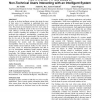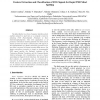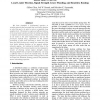521 search results - page 82 / 105 » Learning By Observation Using Qualitative Spatial Relations |
ECCV
2010
Springer
14 years 21 days ago
2010
Springer
Abstract. In many cases, human actions can be identified not only by the singular observation of the human body in motion, but also properties of the surrounding scene and the rel...
CHI
2007
ACM
14 years 8 months ago
2007
ACM
In order to develop intelligent systems that attain the trust of their users, it is important to understand how users perceive such systems and develop those perceptions over time...
AR
2006
13 years 7 months ago
2006
The development and expression of many higher level cognitive functions, such as imitation, spatial perception, and tool-use relies on a multi-modal representation of the body kno...
ICMLA
2009
13 years 5 months ago
2009
The Mind Speller is a Brain-Computer Interface which enables subjects to spell text on a computer screen by detecting P300 Event-Related Potentials in their electroencephalograms....
IPPS
2005
IEEE
14 years 1 months ago
2005
IEEE
We have identified a fundamental operator in wireless networks that we named the local leader election in which the goal is to select a node in a spatially close neighborhood. We ...



